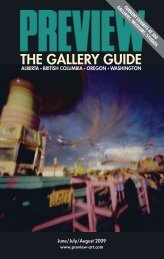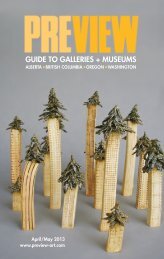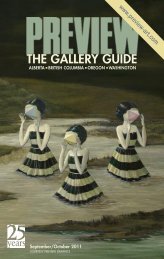Nov 2006âJan 2007 - Preview
Nov 2006âJan 2007 - Preview
Nov 2006âJan 2007 - Preview
- No tags were found...
Create successful ePaper yourself
Turn your PDF publications into a flip-book with our unique Google optimized e-Paper software.
BEHIND THE SCENESIf it’s not Phytosanitary, it might languish in Halifax!BY ANN ROSENBERGImagine this. You are a professional artist accustomed to packingand shipping your work. In August 2006 you decide to importpaintings back to Canada which had been in Europe for fiveyears. When the crate arrives in Halifax, there is a call to informyou that the Canada Customs wood expert has placed shipment#265999 “under detention”. There will be “charges for a fullexam”.Several phone calls were required to find out what this wasabout. The artist had his pine and plywood containers made longbefore July 5, 2006, when the strict rules about the exportationand importation of crates had been put in place by the CanadaFood Inspection Agency. The CFIA’s special interest in such matters reflects the Government ofCanada’s desire to protect this country from all threats, including those posed to the environmentthrough harmful pests and invasive alien species. Plant materials of all kinds, including wood, are ofinterest. (Phyto is the Greek word for plant.)As of the date mentioned above, the government vowed to impound shipments containing woodpackaging that did not meet Canadian import requirements.“Wood packaging must be treated, marked or have a valid Phytosanitary Certificate and be freeof living pests.” Shipments showing signs of infestation will be “immediately safeguarded” and “willbe refused entry”.The same standards for Phytosanitary Measures apply for Canada, the United States and Mexicoand many other countries are enforcing similar regulations. Detailed information about all aspectsof wood packaging regulations; fees regarding the inspection of crates and the disposal of infectedwood products can be obtained through the Canadian Food Inspection Agency at www.inspection.gc.ca/english.Everyone would agree that alien pests are no laughing matter. One would no more wish toexport the Western Mountain Pine Beetle that is killing our forests in B.C. to Asia, than one wouldwant to help the Long Horn Beetle that flourishes there, for example, to come here to put our woodin further jeopardy. What seems unfair in this instance is that the mistake over something thepainter (and indeed the European shipper) could not have known about (considering a one-monthlead time) will cost the artist almost $2,000 more than the crate’s typical trip home would have. Thisshort article is intended to alert galleries and artists to the newly instituted regulations regardingwooden crates, in the hope that they can avoid costly mistakes.I have spoken to people in ten galleries who are involved in international shipping and only afew were aware, in detail, about Phytosanitary packaging requirements. Ken Stephens of DenbighDesign seemed very familiar with the new rules and has never had trouble at the border with thecrates he has constructed. In Vancouver, Can-Crate Industries Limited and Cratex are certified toproduce approved packages out of appropriately treated materials, as are Artech Inc. in Seattle andArtwork Fine Art Services in Portland. All these businesses have personnel who have had professionaltraining in this area of expertise.Methods for debugging a crate remind me of the lab-talk in CSI MIAMI where what the “Perp”has done to the “Vic” is described in gruesome detail. Non-compliant wood packaging can be incinerated,subjected to “deep burial within a period prescribed by an inspector… to a depth of no lessthan three metres (in a place) that won’t ‘be disturbed’ ”. Or it may be subjected to heat treatment,kiln drying, fumigation and/or processing into other wood products like wood dust, wood mulchand wood fuel before it can be declared a non-problem.Ann Rosenberg is a freelance curator, critic and author.NEXT ISSUE: To label or not to label.16 PREVIEW
















